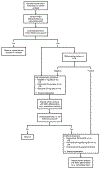Evaluation and management of male genital tract infections in the setting of male infertility: an updated review
- PMID: 36861760
- PMCID: PMC10073322
- DOI: 10.1097/MOU.0000000000001081
Evaluation and management of male genital tract infections in the setting of male infertility: an updated review
Abstract
Purpose of review: Male infertility may be secondary to male genital tract infection (MGTI) in an estimated 15% of cases. In the absence of overt clinical signs, evaluation for MGTI beyond semen analysis is not well established. Therefore, we review the literature on the evaluation and management of MGTI in the setting of male infertility.
Recent findings: A set of international guidelines recommends semen culture and PCR testing, but the significance of positive results remains unclear. Clinical trials evaluating anti-inflammatory or antibiotic treatment report improvements in sperm parameters and leukocytospermia, but data on the effect on conception rates are lacking. Human papillomavirus (HPV) and the novel coronavirus (SARS-CoV-2) have been associated with poor semen parameters and decreased conception rates.
Summary: The finding of leukocytospermia on semen analysis prompts further evaluation for MGTI, including focused physical examination. The role of routine semen culture is controversial. Treatment options include anti-inflammatories; frequent ejaculation; and antibiotics, which should not be used in the absence of symptoms or microbiological infection. SARS-CoV-2 represents a subacute threat to fertility that should be screened for in the reproductive history along with HPV and other viruses.
Copyright © 2023 Wolters Kluwer Health, Inc. All rights reserved.
Conflict of interest statement
Conflicts of interest
None.
Figures
References
Publication types
MeSH terms
Grants and funding
LinkOut - more resources
Full Text Sources
Medical
Research Materials
Miscellaneous


